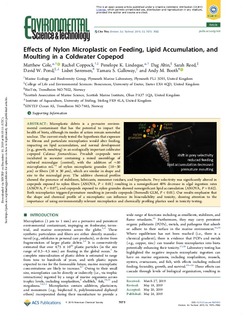| dc.contributor.author | Cole, Matthew | |
| dc.contributor.author | Coppock, Rachel | |
| dc.contributor.author | Lindeque, Pennie K. | |
| dc.contributor.author | Altin, Dag | |
| dc.contributor.author | Reed, Sarah | |
| dc.contributor.author | Pond, David | |
| dc.contributor.author | Sørensen, Lisbet | |
| dc.contributor.author | Galloway, Tamara S. | |
| dc.contributor.author | Booth, Andy | |
| dc.date.accessioned | 2019-12-16T11:13:39Z | |
| dc.date.available | 2019-12-16T11:13:39Z | |
| dc.date.created | 2019-05-31T09:51:46Z | |
| dc.date.issued | 2019-05-24 | |
| dc.identifier.citation | Environmental Science and Technology. 2019, 53 (12), 7075-7082. | nb_NO |
| dc.identifier.issn | 0013-936X | |
| dc.identifier.uri | http://hdl.handle.net/11250/2633375 | |
| dc.description.abstract | Microplastic debris is a pervasive environmental contaminant that has the potential to impact the health of biota, although its modes of action remain somewhat unclear. The current study tested the hypothesis that exposure to fibrous and particulate microplastics would alter feeding, impacting on lipid accumulation, and normal development (e.g., growth, moulting) in an ecologically important coldwater copepod Calanus finmarchicus. Preadult copepods were incubated in seawater containing a mixed assemblage of cultured microalgae (control), with the addition of ∼50 microplastics mL–1 of nylon microplastic granules (10–30 μm) or fibers (10 × 30 μm), which are similar in shape and size to the microalgal prey. The additive chemical profiles showed the presence of stabilizers, lubricants, monomer residues, and byproducts. Prey selectivity was significantly altered in copepods exposed to nylon fibers (ANOVA, P < 0.01) resulting in a nonsignificant 40% decrease in algal ingestion rates (ANOVA, P = 0.07), and copepods exposed to nylon granules showed nonsignificant lipid accumulation (ANOVA, P = 0.62). Both microplastics triggered premature moulting in juvenile copepods (Bernoulli GLM, P < 0.01). Our results emphasize that the shape and chemical profile of a microplastic can influence its bioavailability and toxicity, drawing attention to the importance of using environmentally relevant microplastics and chemically profiling plastics used in toxicity testing. | nb_NO |
| dc.description.sponsorship | Funding was provided by the Natural Environment Research Council (NE/L007010, NE/L002582/1, NE/P006280/1, and NE/L002434/1), the JPI Oceans project “PLASTOX” (direct and indirect ecotoxicological impacts of microplastics on marine organisms; Research Council of Norway, grant no. 257479), and the RCN project “MICROFIBRE” (grant no. 268404). Our thanks to Iurgi Salaberria for assistance in planning the studies and providing access to facilities at NTNU. | nb_NO |
| dc.language.iso | eng | nb_NO |
| dc.publisher | ACS Publications | nb_NO |
| dc.rights | Navngivelse 4.0 Internasjonal | * |
| dc.rights.uri | http://creativecommons.org/licenses/by/4.0/deed.no | * |
| dc.title | Effects of nylon microplastic on feeding, lipid accumulation and moulting in a coldwater copepod | nb_NO |
| dc.type | Journal article | nb_NO |
| dc.type | Peer reviewed | nb_NO |
| dc.description.version | publishedVersion | nb_NO |
| dc.rights.holder | Copyright © 2019 American Chemical Society - © ACS AuthorChoice with CC-BY License https://pubs.acs.org/page/policy/authorchoice_ccby_termsofuse.html | nb_NO |
| dc.source.pagenumber | 7075-7082 | nb_NO |
| dc.source.volume | 53 | nb_NO |
| dc.source.journal | Environmental Science and Technology | nb_NO |
| dc.source.issue | 12 | nb_NO |
| dc.identifier.doi | 10.1021/acs.est.9b01853 | |
| dc.identifier.cristin | 1701730 | |
| dc.relation.project | Norges forskningsråd: 257479 | nb_NO |
| dc.relation.project | Norges forskningsråd: 268404 | nb_NO |
| cristin.unitcode | 7566,6,0,0 | |
| cristin.unitname | Miljø og nye ressurser | |
| cristin.ispublished | true | |
| cristin.fulltext | original | |
| cristin.qualitycode | 2 | |

